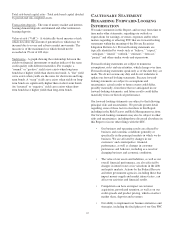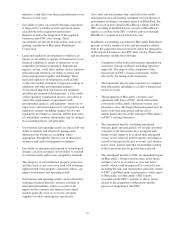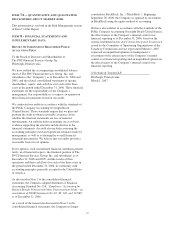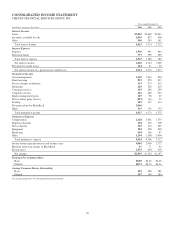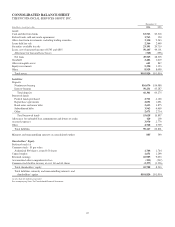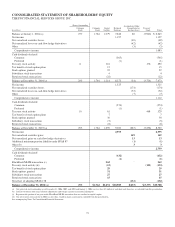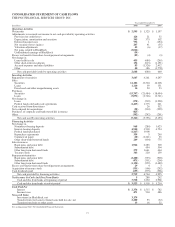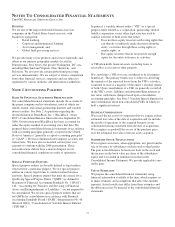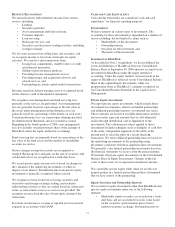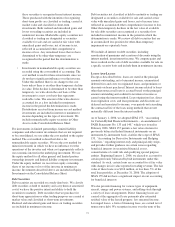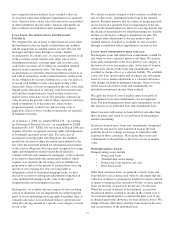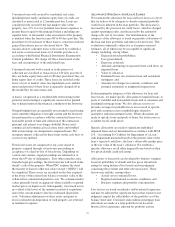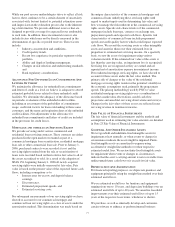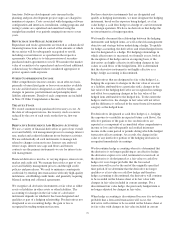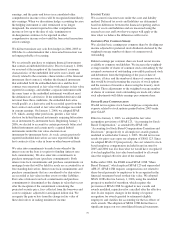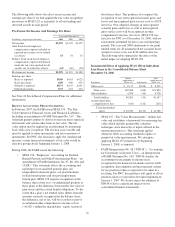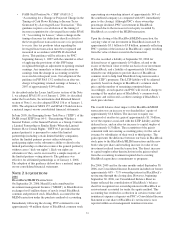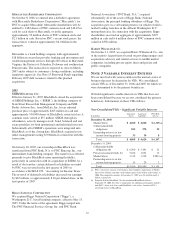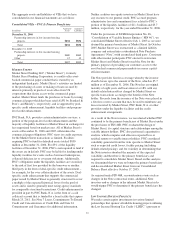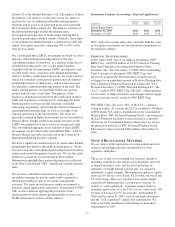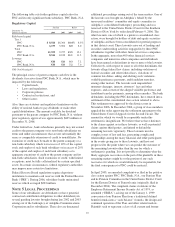PNC Bank 2006 Annual Report Download - page 85
Download and view the complete annual report
Please find page 85 of the 2006 PNC Bank annual report below. You can navigate through the pages in the report by either clicking on the pages listed below, or by using the keyword search tool below to find specific information within the annual report.lease using the interest method. Lease residual values are
reviewed for other-than-temporary impairment on a quarterly
basis. Gains or losses on the sale of leased assets are included
in other noninterest income while valuation adjustments on
lease residuals are included in other noninterest expense.
L
OAN
S
ALES
,S
ECURITIZATIONS
A
ND
R
ETAINED
I
NTERESTS
We recognize the sale of loans or other financial assets when
the transferred assets are legally isolated from our creditors
and the appropriate accounting criteria are met. We also sell
mortgage and other loans through secondary market
securitizations. In certain cases, we may retain a portion or all
of the securities issued, interest-only strips, one or more
subordinated tranches, servicing rights and, in some cases,
cash reserve accounts, all of which are considered retained
interests in the transferred assets. Our loan sales and
securitizations are generally structured without recourse to us
and with no restrictions on the retained interests. In the event
we are obligated for recourse liabilities in a sale, our policy is
to record such liabilities at fair value upon closing of the
transaction. Gains or losses recognized on the sale of the loans
depend on the allocation of carrying value between the loans
sold and the retained interests, based on their relative fair
market values at the date of sale. We generally estimate fair
value based on the present value of future expected cash flows
using assumptions as to discount rates, interest rates,
prepayment speeds, credit losses and servicing costs, if
applicable. Gains or losses on these transactions are reported
in noninterest income.
As of January 1, 2006, we adopted SFAS 156, “Accounting
for Servicing of Financial Assets – an amendment of FASB
Statement No. 140.” SFAS 156 was issued in March 2006 and
requires all newly recognized servicing rights and obligations
to be initially measured at fair value. For each class of
recognized servicing rights and obligations, the standard
permits the election of either the amortization method or the
fair value measurement method for subsequent measurement
of the asset or obligation. For separately recognized servicing
rights and obligations retained or purchased related to
commercial loans and commercial mortgages, we have elected
to account for them under the amortization method, which
requires us to amortize the servicing assets or liabilities in
proportion to and over the periods of estimated net servicing
income or net servicing loss. For servicing rights or
obligations related to residential mortgage loans, we have
elected to account for subsequent adjustments using the fair
value method with changes in the value of the right or
obligation reflected in noninterest income.
Each quarter, we evaluate our servicing assets that are being
carried at amortized cost for impairment by categorizing the
pools of assets underlying servicing rights by product type. A
valuation allowance is recorded and reduces current income
when the carrying amount of a specific asset category exceeds
its fair value.
We classify securities retained as debt securities available for
sale or other assets, depending on the form of the retained
interest. Retained interests that are subject to prepayment risk
are reviewed on a quarterly basis for impairment. If the fair
value of the retained interest is below its carrying amount and
the decline is determined to be other-than-temporary, then the
decline is reflected as a charge to noninterest income. We
recognize other adjustments to the fair market value of
retained interests classified as available for sale securities
through accumulated other comprehensive income or loss.
L
OANS
A
ND
C
OMMITMENTS HELD FOR SALE
We designate loans and related loan commitments as held for
sale when we have a positive intent to sell them. We transfer
loans and commitments to the loans held for sale category at
the lower of cost or fair market value. At the time of transfer,
related write-downs on the loans and commitments are
recorded as charge-offs or as a separate liability. We establish
a new cost basis upon transfer and recognize any subsequent
lower of cost or market adjustment as a valuation allowance
with charges included in noninterest income. Gains or losses
on the actual sale of these loans and commitments are
included in noninterest income when realized.
We apply the lower of cost or market analysis on pools of
homogeneous loans and commitments on a net aggregate
basis. For non-homogeneous loans and commitments, we do
this analysis on an individual loan and commitment basis.
Interest income with respect to loans held for sale other than
those in nonaccrual status is accrued based on the principal
amount outstanding.
In certain circumstances, loans and commitments designated
as held for sale may be later transferred back to the loan
portfolio based on a change in strategy to retain the credit
exposure to those customers. We transfer these loans and
commitments to the portfolio at the lower of cost or market
value.
N
ONPERFORMING
A
SSETS
Nonperforming assets include:
• Nonaccrual loans,
• Troubled debt restructurings,
• Nonaccrual loans held for sale, and
• Foreclosed assets.
Other than consumer loans, we generally classify loans and
loans held for sale as nonaccrual when we determine that the
collection of interest or principal is doubtful or when a default
of interest or principal has existed for 90 days or more and the
loans are not well-secured or in the process of collection.
When the accrual of interest is discontinued, accrued but
uncollected interest credited to income in the current year is
reversed and unpaid interest accrued in the prior year, if any,
is charged against the allowance for loan and lease losses. We
charge off loans other than consumer loans based on the facts
and circumstances of the individual loan.
75


